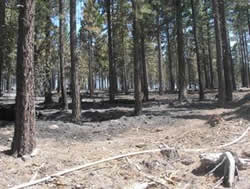
National Fire Plan Success Story
Calpine Defensible Fuel Profile Zone Demonstrates Effectiveness
Sierraville Ranger District, Tahoe National Forest
National Fire Plan - Fuels Reduction
2007

An area in treated stand after the fire. Photo by: Tim Evans, 2007.
Project Description
The Calpine defensible fuel profile zone (DFPZ) is located on the Tahoe National Forest's Sierraville Ranger District. It surrounds the community of Calpine, CA in the Sierra Valley. Treatments to the mixed conifer stands are designed to reduce hazard fuels, decrease wildfire severity, and protect the natural resources and homes of the Calpine community.
The Calpine DFPZ project began in the 1990s and continued to evolve into a multiphase project. The project activities have included thinning, mechanical fuel treatments, and multiple entry prescribed fire treatments. The Tahoe NF has used local contractors, and force account fuels and fire crews to implement the treatments. The Herger Feinstein Quincy Library Group Act (QLG) has primarily funded the DFZP projects. The Calpine DFPZ project is continuing to protect the community of Calpine and its surrounding resources from catastrophic wildland fire by reducing hazardous fuels and creating a safer fire environment for local fire managers. On June 23, 2007, the Calpine Fire tested the Calpine DFPZ. The DFPZ functioned as designed and reduced fire severity and allowed crews to suppress the fire quickly.
Calpine DFPZ Effectiveness Tested
The effectiveness of the Calpine DFPZ was tested on June 23, 2007, when the Calpine Fire started just to the northwest of the community of Calpine. The fire burned through both treated and untreated areas, and was contained under 50 acres utilizing a local Type 3 management team.
The success of the DFPZ during the Calpine Fire was sampled for evaluation in a recent draft report: "Evaluating the Success of Fuels Treatments On Initial Attack Fires", by David Kerr of the U.S. Forest Service. It was found that fire severity in the Calpine fire was quantifiably less in the treated areas then in the non-treated area. The fire crowned through non-treated areas and dropped to the ground in the treated area. The treatment areas provided safe anchor points for crews, increased line production rates, as well as allowed for increase effectiveness of aerial retardant drops.
The Calpine DFPZ demonstrated the ability to reduce fire severity significantly. It provided suppression forces a safer operating environment and enhanced suppression efforts. These factors allowed the fire to be contained during the first operational period at a reduced size. A local type 3 team successfully managed the fire resulting in decreased suppression cost and resource commitment.
The Calpine DFPZ has proven itself to be effective in reducing fire size and providing protection to natural resources and the community of Calpine.
Contact: Eric Petterson, District Fuels Officer, Sierraville Ranger District, Tahoe National Forest, 530-994-3401.
Reference
Kerr, David. 2007. Evaluating the Success of Fuels Treatments on Initial Attack Fires (draft). US Forest Service, Adaptive Management Service Enterprise Team.